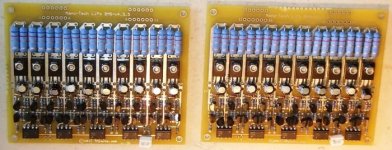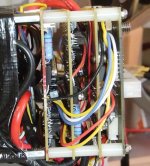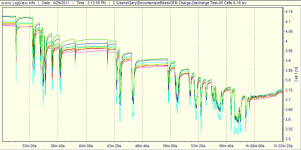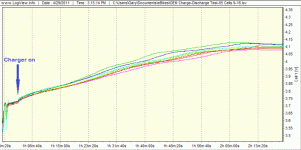GGoodrum
1 MW
So, awhile back I bought a GEM e4. I love it, as it has just enough range that I can run errands around where we live. My typical round trips are about 12-15 miles. This GEM came with six 100Ah gel-type batteries. The model I bought used is a 2007 and the gels are supposed to last about 4 years. Sure enough, a couple months after I bought it, the gels started going south, so I replaced them. Normally, on relatively flat terrain, the range would be about 25 miles, but where I live it is pretty hilly so that range is cut down significantly, to 15-18 miles, mainly due to the gel voltage sagging quite a bit, going up the hills.
The GEM has a speed limiter that keeps the top speed at 25-26 mph, and it also has a current limiter that keeps the continuous current down to about 200A. I have seen initial peaks, starting off, of around 350A, but going up a hill, it never gets above about 190A. To do that, however, the dreaded Peukert Effect kicks in, and the voltage will sag down as low as 60V, from a normal 75-79V resting range.
The first thing I decided to do something about was getting the top speed up a bit. The easiest way was to swap out the stock motor with the 7.5hp version sold by the folks at http://www.ride-4-fun.com. They have a modified speed sensor that basically "fools" the controller into thinking it is going slower than it really is. Twice as slow, actually. This change alone, got the top speed up to about 33-34 mph. To get that over 40 mph, I replaced the stock 12" wheels and tires with 14" versions, also from ride-4-fun.com.
This change alone, got the top speed up to about 33-34 mph. To get that over 40 mph, I replaced the stock 12" wheels and tires with 14" versions, also from ride-4-fun.com.
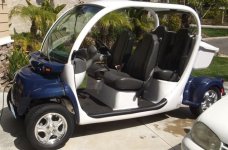
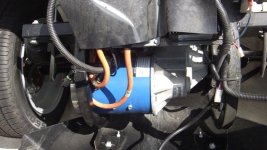
Now that I have essentially a 40mph+ golf cart, which is a kick-in-the-pants to drive, I decided I really needed to do something about its hill climbing performance. Sure, I could simply replace the six 12V gel batteries with a roughly equivalent LiPo or LiFePO4 setup, but that would be pretty expensive. Even if you assume that I'm only getting about 60Ah of useful capacity out of the gels, a 24s5p setup of PSI 12Ah cells, at roughly $25 each, would be about $3000. That's pretty steep, when you consider I wouldn't get any additional range to speak of. Going a full LiPo route would also be too costly. If I did a 20s12p of Turnigy/Zippys, for instance, the cost is still going to be well over $2000. Had I not already spent close to $1800 to replace the gels, I might have considered this route, but only if I went to a higher capacity, so that I'd get more range than I'm getting now. Again, back closer to $3k.
I then stepped back, to look at the problem from a different angle. I decided that I could simply add a Lithium-based booster pack to the gels, if I could sort out keeping the booster pack off, when it wasn't needed, and if it could be charged at the same time as the gels, using the GEM's built-in 15A DeltaQ "smart" charger. The first thing i needed to do was document how much current was being drawn, at what voltages, during discharge, and then monitor what the DeltaQ did for charging profiles. It turns out the max drain is limited to about 180-190A, going up the hills, with the voltage, even with the gels right off the charger, dipping down to about 66-67V. When the gels were about half-full, I saw it go down to about 60V. This is easy enough to take care of, just using the "standard" active cutoff circuits we've used for LVC, but just in reverse. The FETs need to stay off, until the voltage on the gels sag, and then turn on.
The charging side proved to be a bit more challenging. It turns out the DelaQ has three separate CV hold points, and then an odd equalization phase at the end. It starts out in the CC mode, with a full 15A. When the voltage gets to 82.8V, it holds there, and lets the current drop down to about 6A. It then sets the CV point up to 85.6V, and the current goes back up to about 12A. It slowly drops down to about 2A, and then the CV point is again raised, to about 88.7V, where it stays until the current drops down to about 1A. At that point, the equalization phase kicks in, where the current is kept at 2A and the voltage is allowed to rise up to 98-99V.
The first CV point, of 82.8V is perfect for a 20s LiPo pack, as the voltage per cell is 4.14V. The second CV point of 85.6V is better, for a 24s LiFePO4 setup, as it is about 3.57V per cell. In either case, what is needed is the same sort of active cutoff circuit, but for charging, where the charge current cuts off above a certain value, about 83V for LiPo and about 86V for LiFePO4.
Originally, I was thinking of using a 24s2p 77V/24Ah PSI-based booster pack, but in my experience these cells are at best 7-8C, under load, so a 2p configuration just wouldn't cut it. There would still be significant voltage sag, which defeats the purpose. I then settled in on using the new Turnigy 25-50C 10s1p "Nanotech" packs. With four of these, I end up with a 20s2p 76V/10Ah booster pack, about the size of a loaf of bread. My only real question was whether or not 10Ah would be enough to last the duration of the 100Ah gels, only kicking in when needed. As it turns out, it is just fine. When the gels are done, the booster pack is down about 80%. Anyway, I'm getting ahead of myself.
Getting back to the special BMS control circuit I needed, I finally ended up using 12 IRFB4110 FETs, in a 2x6, back-to-back configuration, six for discharge and six for charging. Since the charger only puts out 15A max, six for charging may seem like way too many, but in this configuration, the charge side FETs are used in the "perfect diode" mode, when discharging. Richard helped me figure out how to do the control portion, which turns the discharge FETs on, when the gel voltage dips under 70V, or so, and then keeps them on for about 14 seconds. The reason for this is that once the booster pack kicks in, the gel voltage is going to get pulled up, so it would turn the FETs off again. I "fine-tuned" the delay for cutting the FETs off again so that I could make sure I could get up the longest hill.
For charging, a similar circuit is used, but without the delay. It is set to keep the FETs on, as long as the charge voltage is under 83.2V. Once the charge goes to the second CV point, the charge-side FETs are cutoff. Both of these controls are implemented using a pair of the same TC54 chips we use in the cell circuits, with the voltages set via a three-resistor divider. Here's the schematic:

As can be seen, I also added a standard LVC/HVC opto input, to connect to the standard v4.4-type BMS cell circuits. For packaging, I decided to do the boards in a stacked fashion, that can mount on the front of the four Nanotech packs. Here's what the boards ended up looking like:
View attachment 5
There are two identical 10-channel cell circuit boards, which are basically the same as the v4.4 BMS cell circuits, but without the LEDs, and related logic. These boards can also serve as parallel adapters for the balancer plugs on the Nanotech packs. The control board has the 12 FETs, plus the rest of the control logic. It also has pads at the bottom and top for connections to the main pack connections, one for each 2p "side" of the pack. Finally, there are holes/pads for two 1/4-20 stainless steel bolts, which serve as the main booster pack connection points. The 4th board is a sort of "cover" plate, on which I added two 18-pin VAL-U-LOK connectors. These I use for plugging in a test box I made up that has three 8-channel CellLog units. This is handy to do a quick health check on the individual cell groups.
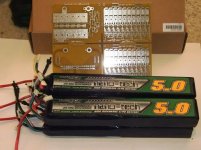
The best part about this setup is that the only connections that need to be made to install this in the GEM are two big battery cables that connect to the main gel + and - connections. Operation of the various modes is completely automatic. It kicks in during discharge, when it needs to, charges using the same built-in charger until the Nanaotech cells get to 4.14V, and then shuts down while the charger finishes charging the gels.
For the installation, the GEM battery compartment has plenty of room for this "loaf of bread" add-on. There is a steel bar that runs over the top of four of the gels, to hold them in place. I simply added a 3" aluminum plate to the top of this bar, using some U-bolts. The booster pack simply sits on top of this plate, held there with heavy-duty Velcro strips and some Velcro straps. Here's a couple shots of the installation:


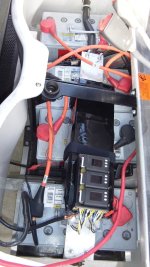
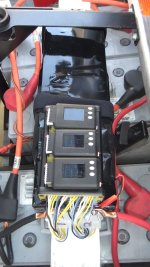
I've been using the CellLogs to record data, during discharging and during the charge process. Quite handy, for testing. Initially, I've also been using the CellLogs programmable LVC and HVC set points, to help figure out the optimum set points. In fact, the pack setup in the pics above, does not have the cell circuits. I didn't want to have to keep changing resistor values, for 20 channels. For my testing process, I've just used external balancers, to get the cells back in balance, when needed, which really was only the first few cycles. They are staying much more closely balanced now, but I haven't discharged the whole pack down below about halfway for the last few cycles. That will change, however, because my next series of tests will be to drain both the gels and the booster pack to empty, to verify that 10Ah is truly enough. It has been my experience that even healthy cells will start to get unbalanced, once you get down to where there's less than about 20% left in the "tank".
For my testing process, I've just used external balancers, to get the cells back in balance, when needed, which really was only the first few cycles. They are staying much more closely balanced now, but I haven't discharged the whole pack down below about halfway for the last few cycles. That will change, however, because my next series of tests will be to drain both the gels and the booster pack to empty, to verify that 10Ah is truly enough. It has been my experience that even healthy cells will start to get unbalanced, once you get down to where there's less than about 20% left in the "tank".  Anyway, this weekend, I'm going to take the shrink wrap off, and add the two cell circuit balance boards, with properly tweaked LVC and HVC set points. After that, I'm going to take off the CellLog box, and seal up the enclosure. Actually, that just involves putting the back seat back in.
Anyway, this weekend, I'm going to take the shrink wrap off, and add the two cell circuit balance boards, with properly tweaked LVC and HVC set points. After that, I'm going to take off the CellLog box, and seal up the enclosure. Actually, that just involves putting the back seat back in. 
I'll try and post some discharge/charge graphs later, and maybe a video. I'm quite pleased with the results. I no longer get the huge sag, and subsequent slowing down, going up a hill. It just blasts over the top now. I'm also seeing quite a big jump in range. I haven't quantified it yet, but the added benefit of not having the voltage sag, going up hills, means the gels are not being worked as hard, so I get more capacity out of them. Definitely a win-win. :wink:
I'm also seeing quite a big jump in range. I haven't quantified it yet, but the added benefit of not having the voltage sag, going up hills, means the gels are not being worked as hard, so I get more capacity out of them. Definitely a win-win. :wink: 
-- Gary
The GEM has a speed limiter that keeps the top speed at 25-26 mph, and it also has a current limiter that keeps the continuous current down to about 200A. I have seen initial peaks, starting off, of around 350A, but going up a hill, it never gets above about 190A. To do that, however, the dreaded Peukert Effect kicks in, and the voltage will sag down as low as 60V, from a normal 75-79V resting range.
The first thing I decided to do something about was getting the top speed up a bit. The easiest way was to swap out the stock motor with the 7.5hp version sold by the folks at http://www.ride-4-fun.com. They have a modified speed sensor that basically "fools" the controller into thinking it is going slower than it really is. Twice as slow, actually.


Now that I have essentially a 40mph+ golf cart, which is a kick-in-the-pants to drive, I decided I really needed to do something about its hill climbing performance. Sure, I could simply replace the six 12V gel batteries with a roughly equivalent LiPo or LiFePO4 setup, but that would be pretty expensive. Even if you assume that I'm only getting about 60Ah of useful capacity out of the gels, a 24s5p setup of PSI 12Ah cells, at roughly $25 each, would be about $3000. That's pretty steep, when you consider I wouldn't get any additional range to speak of. Going a full LiPo route would also be too costly. If I did a 20s12p of Turnigy/Zippys, for instance, the cost is still going to be well over $2000. Had I not already spent close to $1800 to replace the gels, I might have considered this route, but only if I went to a higher capacity, so that I'd get more range than I'm getting now. Again, back closer to $3k.
I then stepped back, to look at the problem from a different angle. I decided that I could simply add a Lithium-based booster pack to the gels, if I could sort out keeping the booster pack off, when it wasn't needed, and if it could be charged at the same time as the gels, using the GEM's built-in 15A DeltaQ "smart" charger. The first thing i needed to do was document how much current was being drawn, at what voltages, during discharge, and then monitor what the DeltaQ did for charging profiles. It turns out the max drain is limited to about 180-190A, going up the hills, with the voltage, even with the gels right off the charger, dipping down to about 66-67V. When the gels were about half-full, I saw it go down to about 60V. This is easy enough to take care of, just using the "standard" active cutoff circuits we've used for LVC, but just in reverse. The FETs need to stay off, until the voltage on the gels sag, and then turn on.
The charging side proved to be a bit more challenging. It turns out the DelaQ has three separate CV hold points, and then an odd equalization phase at the end. It starts out in the CC mode, with a full 15A. When the voltage gets to 82.8V, it holds there, and lets the current drop down to about 6A. It then sets the CV point up to 85.6V, and the current goes back up to about 12A. It slowly drops down to about 2A, and then the CV point is again raised, to about 88.7V, where it stays until the current drops down to about 1A. At that point, the equalization phase kicks in, where the current is kept at 2A and the voltage is allowed to rise up to 98-99V.
The first CV point, of 82.8V is perfect for a 20s LiPo pack, as the voltage per cell is 4.14V. The second CV point of 85.6V is better, for a 24s LiFePO4 setup, as it is about 3.57V per cell. In either case, what is needed is the same sort of active cutoff circuit, but for charging, where the charge current cuts off above a certain value, about 83V for LiPo and about 86V for LiFePO4.
Originally, I was thinking of using a 24s2p 77V/24Ah PSI-based booster pack, but in my experience these cells are at best 7-8C, under load, so a 2p configuration just wouldn't cut it. There would still be significant voltage sag, which defeats the purpose. I then settled in on using the new Turnigy 25-50C 10s1p "Nanotech" packs. With four of these, I end up with a 20s2p 76V/10Ah booster pack, about the size of a loaf of bread. My only real question was whether or not 10Ah would be enough to last the duration of the 100Ah gels, only kicking in when needed. As it turns out, it is just fine. When the gels are done, the booster pack is down about 80%. Anyway, I'm getting ahead of myself.
Getting back to the special BMS control circuit I needed, I finally ended up using 12 IRFB4110 FETs, in a 2x6, back-to-back configuration, six for discharge and six for charging. Since the charger only puts out 15A max, six for charging may seem like way too many, but in this configuration, the charge side FETs are used in the "perfect diode" mode, when discharging. Richard helped me figure out how to do the control portion, which turns the discharge FETs on, when the gel voltage dips under 70V, or so, and then keeps them on for about 14 seconds. The reason for this is that once the booster pack kicks in, the gel voltage is going to get pulled up, so it would turn the FETs off again. I "fine-tuned" the delay for cutting the FETs off again so that I could make sure I could get up the longest hill.
For charging, a similar circuit is used, but without the delay. It is set to keep the FETs on, as long as the charge voltage is under 83.2V. Once the charge goes to the second CV point, the charge-side FETs are cutoff. Both of these controls are implemented using a pair of the same TC54 chips we use in the cell circuits, with the voltages set via a three-resistor divider. Here's the schematic:

As can be seen, I also added a standard LVC/HVC opto input, to connect to the standard v4.4-type BMS cell circuits. For packaging, I decided to do the boards in a stacked fashion, that can mount on the front of the four Nanotech packs. Here's what the boards ended up looking like:
View attachment 5
There are two identical 10-channel cell circuit boards, which are basically the same as the v4.4 BMS cell circuits, but without the LEDs, and related logic. These boards can also serve as parallel adapters for the balancer plugs on the Nanotech packs. The control board has the 12 FETs, plus the rest of the control logic. It also has pads at the bottom and top for connections to the main pack connections, one for each 2p "side" of the pack. Finally, there are holes/pads for two 1/4-20 stainless steel bolts, which serve as the main booster pack connection points. The 4th board is a sort of "cover" plate, on which I added two 18-pin VAL-U-LOK connectors. These I use for plugging in a test box I made up that has three 8-channel CellLog units. This is handy to do a quick health check on the individual cell groups.

The best part about this setup is that the only connections that need to be made to install this in the GEM are two big battery cables that connect to the main gel + and - connections. Operation of the various modes is completely automatic. It kicks in during discharge, when it needs to, charges using the same built-in charger until the Nanaotech cells get to 4.14V, and then shuts down while the charger finishes charging the gels.
For the installation, the GEM battery compartment has plenty of room for this "loaf of bread" add-on. There is a steel bar that runs over the top of four of the gels, to hold them in place. I simply added a 3" aluminum plate to the top of this bar, using some U-bolts. The booster pack simply sits on top of this plate, held there with heavy-duty Velcro strips and some Velcro straps. Here's a couple shots of the installation:




I've been using the CellLogs to record data, during discharging and during the charge process. Quite handy, for testing. Initially, I've also been using the CellLogs programmable LVC and HVC set points, to help figure out the optimum set points. In fact, the pack setup in the pics above, does not have the cell circuits. I didn't want to have to keep changing resistor values, for 20 channels.
I'll try and post some discharge/charge graphs later, and maybe a video. I'm quite pleased with the results. I no longer get the huge sag, and subsequent slowing down, going up a hill. It just blasts over the top now.
-- Gary



